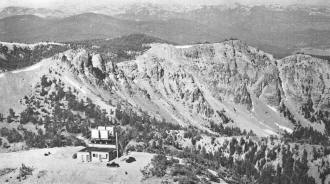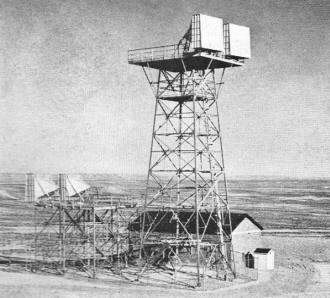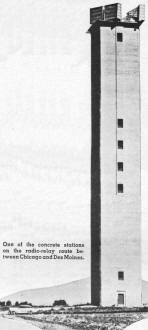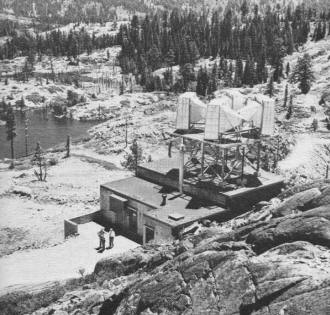Bell System Opens Transcontinental Radio-Relay |
||||||
Billed at the time as the longest microwave relay system in the world, this report on Bell Telephone Systems' transcontinental installation came just a month after being put into commercial service. At a cost of $40 million ($442 million in 2021 dollars per BLS Inflation Calculator) when this article was published in Radio & Television News magazine, the system relays telephone calls and radio and video program material along a chain of 107 microwave towers, spaced approximately 30 miles apart. It was a big deal to be able to watch a TV show from New York City in Los Angeles, and vice versa; we take worldwide broadcasts for granted nowadays. Bell System Opens Transcontinental Radio-Relay Air view of Long Lines radio-relay station at Mt. Rose, Nevada. At an elevation of 10,000 ft., this is highest station in system. By William Alberts Original commercial service provides two TV channels - one east and one west. Other channels will be added as needed. By the time this issue reaches our readers coast-to-coast commercial television will be a reality. This video link has been made possible by the completion of the new microwave radio-relay built by the Long Lines Department of the American Telephone &; Telegraph Co. This new project is the longest microwave system in the world and is the product of years of engineering effort and cooperation by the development, manufacturing, and operating units of the Bell System. The relay was put into temporary service on September 4th to carry the ceremonies in connection with the Japanese Peace Treaty Conference held in San Francisco. Built in about three years at a cost of $40,000,000, the system relays telephone calls and radio and video program material along a chain of 107 microwave towers, spaced approximately 30 miles apart. Radio-relay station at Creston, Wyoming, showing both the receiving and sending microwave antennas at two different levels. Cutaway view of a typical concrete station in Long Lines transcontinental radio-relay system just put into service. One of the concrete stations on the radio-relay route between Chicago and Des Moines. The 200 foot steel tower at Salt Lake City Junction overlooking Salt Lake City and Great Salt Lake. This is one of the 107 stations on the transcontinental relay system. The vast distances, together with the large number of radio channels required, posed many serious problems for the Bell Telephone Laboratories. Three new developments provided the answers. First, a new electronic tube was developed which gave outstanding performance at the super high frequencies. Second, the Laboratories came up with a new improved metal lens which would handle thousands of simultaneous telephone calls. A unique system of filters, representing an entirely new contribution to the field of communications, was developed. All of this electronic equipment was built and installed by the Western Electric Company, the manufacturing unit of the Bell System. Operating in the 4000 mc. range, the new relay system employs amplifying equipment at each station to boost the signal 10,000,000 times before retransmitting. Initially, the system will provide one east-to-west channel for television. The west-to-east channel is expected to be in service within a few weeks. The story of how this vast system came into being is one worthy of the days of pioneering. In locating and constructing the 107 towers comprising the system, the engineers encountered every type of terrain. The first step in determining a tower site involved the study of topographical maps and then an on-the-spot inspection to determine clear paths between prospective stations and the detection of all reflective surfaces, such as water or flat lands, that might impair the signal. To insure best construction conditions and ease of maintenance, the accessibility of the site to all-weather roads had to be considered. Next, sites about 25 miles apart were tentatively selected with alternate sites chosen in each instance. The land for each station was then optioned and field tests were held to determine the transmission and reception quality of that particular location. Unusual view of the Cisco-Butte, California station of the transcontinental relay system. This station is located in a valley high in the Sierra-Nevada mountain range. Following the preliminary tests, borings were made and soil samples taken to determine the type and depth of foundation necessary for each station. In addition to securing the necessary FCC authorization, clearance had to be obtained from the CAA because of the towers and their rulings heeded as to outside lighting for the towers. Depending on the location of the stations, the towers range in height from 40 to 200 feet. In many cases they are concrete buildings with space on the ground floor for a gasoline engine to generate emergency power in case of power line failure. The second and third floors of the stations house the storage batteries and associated power equipment. The amplifying and testing gear is housed on the fourth floor while the top of each station carries the horn-shaped directional antennas. All-in-all this vast engineering feat represents an important addition to the country's communications facilities for both peace and war, provides coast-to-coast network facilities for the transmission of television programs, and opens up thousands of new channels for long distance phone service. With the completion of this new microwave relay system the country now has seven telephone highways crossing the continent.
Posted February 21, 2022
|
||||||






